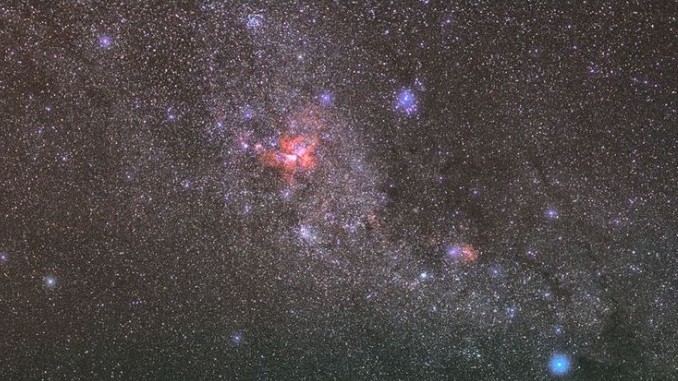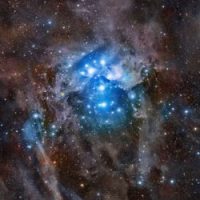Top 10 Deep-Sky Objects for Stargazers

Here is a list of easy binocular and small scope targets that are visible throughout almost the whole year in the Northern hemisphere . Moreover, all the objects in this list are in prominent constellations, making them easy to find should an opportunity to scan the heavens with a pair of binoculars or a small telescope present itself. Enjoy!
Pleiades
– Constellation: Taurus
– Object type: Open cluster
– Coordinates: RA: 03h 47m 24s | Dec: +24° 07’
– Distance: 444 light-years
– Magnitude: 1.6
– Other designations: M45, Seven Sisters,
While it is true that almost every list of this type includes the Pleiades, it is also true that no list of this type should be without it, because this hauntingly beautiful, 100-million-year-old cluster is so much more than the 7 or so stars that are visible to the naked eye. In fact, most people can easily see the six stars of magnitude 2.9 to 4.2, while more challenging are the next four brightest stars which range in magnitude from 5.1 to 6.4.

Sadly though, gravitational interactions with surrounding structures will cause the cluster to break up and disperse in about 250 million years’ time, but until that happens, the Pleiades will remain one of the most strikingly beautiful sights in the entire sky.Although the cluster proper spans only about 13 light years, its tidal radius, or the cluster’s ability to withstand the tidal field of its host Milky Way galaxy, is much bigger, spanning about 43 light years. In terms of its composition, the cluster contains about 3,000 stars that share a common proper motion, which likewise suggests a common origin. While hot, blue stars dominate throughout the Pleiades, it also contains a large number of cool brown dwarf stars that may account for up to 25% of its total stellar population, with the group moving through a predominantly carbon-based cloud, giving the cluster its ethereal blue hue.
Helix Nebula
– Constellation: Aquarius
– Object type: Planetary nebula
– Coordinates: RA: 22h 29m 38.55s | Dec: –20° 50’ 13.6”
– Distance: 700 light-years
– Magnitude: 7.6
– Other designations: NGC 7293, C63
Also known as the Eye of God, no doubt because it looks like a celestial eye, the Helix Nebula is not only one of closest planetary nebula to Earth, being only about 700 light years away, it is also one of largest, spanning about 2.5 light years. While binocular views of the Helix nebula will reveal a distinct, bright patch of light, small scopes of 5-inch aperture and larger will reveal a conspicuous, dark centre “punctuated” by the remains of the progenitor star
Cave Nebula
 – Constellation: Cepheus
– Constellation: Cepheus
– Object type: Emission nebula
– Coordinates: RA: 22h 57m 17.14s | Dec: 62° 28’ 33.4”
– Distance: 2,400 light-years
– Magnitude: 7.7
– Other designations: Caldwell 9, Sh2-155
The Cave Nebula is around 35 light-years across, and consists of a nebula located “inside” a larger nebulous structure that contains emission, reflection, and dark nebulosity. Despite being visually faint, telescopic views reveal a dark, cave-like intrusion into the edge of the larger structure, hence the name, Cave Nebula. Recent investigations into this region seems to suggest that radiation pressure from a close-by type O star (hot, blue-white) may be triggering an intense bout of star formation in this region spanning around 10 light years.
Caroline’s Cluster
 – Constellation: Canis Major
– Constellation: Canis Major
– Object type: Open cluster
– Coordinates: RA: 07h 17m 43s | Dec: –15° 38’ 29”
– Distance: 3,700 light years
– Magnitude: 7.2
– Other designations: NGC 2360, C58
“Caroline”, of course, refers to the sister of William Herschel, who discovered this large open star cluster in February of 1783. Her notes on the discovery described it as a “beautiful cluster of pretty compressed stars near 1/2 degree in diameter,” and it might have remained undiscovered had it not been for brother William who included the discovery in his mammoth catalogue of over 1,000 star clusters. The cluster is located about 3 700 light years away, and contains several “blue stragglers”, which are stars that have either merged with other stars, or have cannibalized nearby stars, thereby making them hotter, and seemingly much younger than they should be, given the overall 2.2 billion year age of the cluster.

Western Veil Nebula
– Constellation: Cygnus
– Object type: Supernova remnant
– Coordinates: RA: 20h 45m 38s | Dec: +30° 42’ 30”
– Distance: 1,470 light-years
– Magnitude: 7.0
– Other designations: NGC 6960, C34
Although the Veil Nebula should really be viewed as a completes structure, it is so large that some parts of it have been given their own names and designations, one of which is the Western Veil Nebula, arguably the most beautiful part of the larger structure. This part of the Veil is illuminated by an unrelated star, 52 Cygni, but for those observers who want to investigate the entire structure with scopes of 8-inch aperture, other parts of the Veil are close by, sporting names such as the Eastern Veil, and Pickering’s – (or Fleming’s) Triangle, depending on the source consulted. As a matter of interest though, the Veil Nebula appears the way it does because the debris cloud released during the supernova event that had created the nebula is moving through the surrounding gas clouds at about 600 000 km/hour, creating complex shock fronts as it expands.
 Bode’s Galaxy
Bode’s Galaxy
– Constellation: Ursa Major
– Object type: Spiral galaxy
– Coordinates: RA: 09h 5m 33.2s | Dec: +69° 03’ 55”
– Distance: 11.8 million light-years
– Magnitude: 6.94
– Other designations: NGC 3031, M81
Located about 12 million light years away, which is relatively close as large galaxies go, Bode’s galaxy is near enough, and bright enough to make it an excellent object of study for professional and amateur astronomers alike. In fact, looking through a 6-inch telescope you will see M81 as a halo of low-level nebulosity surrounding a bright core. The galaxy also contains a very active nucleus, harbouring as it does, a super massive black hole, estimated to weigh in at about 70 million Suns.

E.T. Cluster
– Constellation: Cassiopeia
– Object type: Open cluster
– Coordinates: RA: 01h 19m 32.6s | Dec: +58° 17’ 27”
– Distance: 7,900 light-years
– Magnitude: 6.4
– Other designations: NGC 457, C13, Owl Cluster
Also known as the Owl Cluster, or the Kachina Doll Cluster, this open cluster is one of many in the constellation Cassiopeia, but what makes this particular cluster so inviting to view is its close resemblance to the famous movie character E.T. It is located about 7,900 light years away and contains about 150 stars of magnitude 12-15, but with some imagination, two brighter stars, magnitude 5 Phi-1 Cassiopeiae and magnitude 7 Phi-2 Cassiopeiae, can be imagined as the “eyes” of the lovable movie character.
 Hercules Globular Cluster
Hercules Globular Cluster
– Constellation: Hercules
– Object type: Type V globular cluster
– Coordinates: RA: 16h 41m 41.24s | Dec: +36° 27’ 35.5”
– Distance: 25,100 light-years
– Magnitude: 5.8
– Other designations: NGC 6205, M13
Located about 25,100 light years away, this very big globular cluster containing around 300,000 starts is without doubt the finest globular star cluster in the entire Northern hemisphere sky. Spanning nearly 145 light years, M13 is just at naked eye visibility in good seeing conditions, but a small telescope will reveal a tightly packed ball of stars that at 11.65 billion years old is nearly as old as the Universe itself. The most luminous star in the cluster is a highly evolved, variable red giant known as V11, which has an apparent visual magnitude of 11.95. Look for the Hercules cluster close to the 12th magnitude edge-on galaxy NGC 6207.
 Intergalactic Wanderer
Intergalactic Wanderer
– Constellation: Lynx
– Object type: Type VII globular cluster
– Coordinates: RA: 07h 38m 08.51s | Dec: +38° 52’ 54.9”
– Distance: 275,000 light-years
– Magnitude: 9.06
– Other designations: NGC 2419, C25
Although this globular cluster is located all of 275,000 light-years away, it is easily seen with large binoculars or small telescopes, being intrinsically brighter than some globular clusters that are closer to Earth, shining as it does at an absolute magnitude of -9.42. The cluster got is name erroneously when it was thought at first not to be orbiting the Milky Way, probably due to its great equal distance from Earth and the galactic centre. At its distance, the cluster makes one orbit of the Milky Way every 3 billion years or so, which to hypothetical observers in the Andromeda galaxy, would make it analogous to the way the Andromeda’s Cluster (G1) would look to observers on Earth as it orbits the Andromeda galaxy.
Sombrero Galaxy

– Constellation: Virgo
– Object type: Spiral galaxy
– Coordinates: RA: 12h 39m 59.4s | Dec: –11° 37’ 23”
– Distance: 29.35 million light years
– Magnitude: 8.98
– Other designations: NGC 4594, M104
Even though this perennial favorite of amateur observers is located almost 30 million light years away, a small telescope will easily reveal the dark dust lane that encircles the galaxy, and which gives it the appearance of a Mexican sombrero hat. Apart from its striking look, and being an easy target even for binoculars, this galaxy is thought to contain the most massive black hole discovered to date, estimated to weigh as much as 1 billion Suns, which is unusually massive for a galaxy that is only about 30% as big as the Milky Way. One other feature that makes the Sombrero Galaxy stand out as a target is that it is being swamped by about 2,000 globular clusters, which according to some investigators, is directly related to the mass of the galaxy’s unusually massive central bulge.
